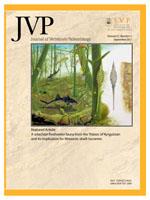Griphotherion peiranoi, a new genus and species of notoungulate from northwestern Argentina, is presented here. The material studied consists of a nearly complete skull and part of the postcranial skeleton, recovered in the Lumbrera Formation (Eocene) at the locality of El Simbolar (Salta Province, northwestern Argentina). The specimen was evaluated in terms of a matrix of 28 craniodental characters and compared with 11 typotherian genera. Additionally, characters of the new taxon were compared to those included in a previously published data matrix that includes several native South American ungulates. The particular features present in the specimen indicate unequivocally that this is a new notoungulate taxon; nevertheless, due to its distinctiveness, we opted not to place the novel taxon in any of the known families of Notoungulata. The results of the analyses performed indicate that G. peiranoi is closely related to Mesotheriidae, Hegetotheriidae, and Archaeohyracidae. These families represent the ‘rodent-like’ notoungulates that evolved during the Late Paleogene and the Neogene. This new record contributes to our knowledge of the Eocene notoungulate fauna of northwerstern Argentina. It also supports the broader perspective that this region played an important role as an area of origin and diversification for several lineages of this remarkable order of endemic South American ungulates.
How to translate text using browser tools
1 September 2011
Griphotherion peiranoi, gen. et sp. nov., A New Eocene Notoungulata (Mammalia, Meridiungulata) from Northwestern Argentina
Daniel A. García López,
Jaime E. Powell
ACCESS THE FULL ARTICLE





